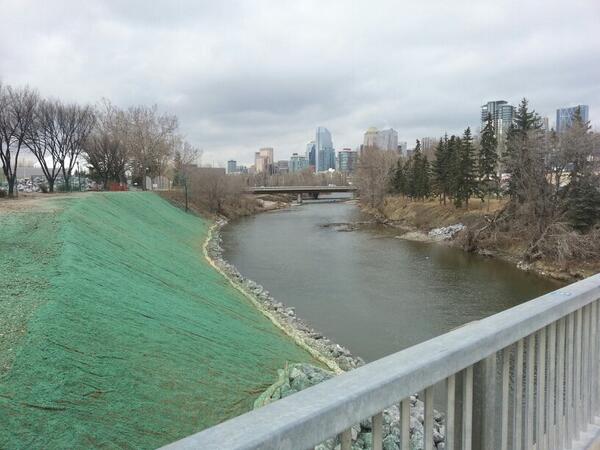Flood Mitigation: Erosion Control
Erosion control is a catch-all phrase encompassing a variety of projects and methods for reducing shoreline erosion along rivers and coastlines. Typically, there are three different categories of erosion control projects, including channel bank armouring, vegetative erosion control, and hard engineered structures. Channel bank armouring includes riprap projects, where rocks are placed along river banks to prevent soil erosion, and gabion structures, where rocks are held back using meshed wiring at various levels to mitigate flooding. Vegetative options include cement-sand bagging and planting more water-retaining vegetation along river and stream beds. Hard engineered structures refer mainly to retaining walls built from concrete that prevent soil and vegetation erosion, but may result in increased rates of channel flow.
Erosion control projects are often described as river bank or coast protection methods. For the purposes of this article, we will use the generic term, “erosion control”.
What is erosion control?
Erosion control is important for protecting manmade structures. It is the practice of re-stabilizing river and stream banks [i] or beaches [ii] to protect developments in the surrounding area. Erosion control measures can use hard engineering, such as retaining walls, to prevent future erosion; however, this prevents natural meandering when used on a river. More naturalized options include gabion structures, riprap, and vegetation to soak up excess water and prevent bank destruction [iii].
How does erosion control help to mitigate the impacts of high-water events?
Erosion control measures may reduce the damage of future high-water events, such as floods, especially in urban areas where developments are located near rivers, streams, or coastlines. As mentioned above, there are various options for erosion control measures. Each option uses a different technique to prevent erosion and has a distinct set of advantages and disadvantages.
Do erosion control measures already exist in Canada?
Yes. After the Southern Alberta flood in 2013, the Government of Alberta initiated the Flood Recovery Erosion Control Program [iv], which eventually reached $116 million. Similarly, the Government of Canada funds erosion control measures in First Nations communities [v].
The following picture shows erosion control construction on the Elbow River at the Calgary Stampede grounds.

What are the costs of erosion control?
The costs of erosion control projects depend on the type of protection chosen, the size of the project, the location, and the ongoing monitoring and maintenance of the protection. The latter two costs are important aspects of the lifetime costs of erosion control measures, which may not be considered when such projects are initially proposed and constructed. A project that has seemingly lower short-term costs may become significantly more expensive if the full lifetime costs are considered.
What is the lifetime expectancy of erosion control?
Depending on the type of erosion control project, lifetime expectancy can vary. Structures such as retaining walls will require continual maintenance over time, while natural options will require less. Due to the natural meandering of a river, erosion control projects will change over time. Therefore, measures that can adapt to the ever-changing river will be more beneficial. Similarly, coastal erosion protection has a wide range of life expectancies and costs [vi].
What are the associated risks?
A major concern with erosion control projects is that soil removed from the site in the construction process increases the potential for poor water quality. Sedimentation and toxic pollution are two examples of water quality issues that can result from the construction process of erosion control projects. Furthermore, soil removal can increase the rate of erosion because important water-retaining vegetation is removed [vii].
What are the impacts on the surrounding watershed system and environment?
While erosion control measures are implemented to prevent damage to development, these projects can impact the environment and local watershed. Specifically, when soil and vegetation is removed for engineered structures, this increases potential storm water runoff, leading to water quality issues and sedimentation. For this reason, it is important for every erosion control project to maintain vegetation so that rain, river, and flood water can be absorbed and released into the river or stream properly and without large amounts of sediment.
Would erosion control help in a drought?
Similar to flooding, drought events can cause erosion due to dry climates, in which wind can remove top soil important for the growth of vegetation. Erosion control measures can help to mitigate the impacts of a drought by maintaining residue, such as top soil and clay, letting vegetation over-grow, and building shelter beds that protect specific areas [viii].
Sources:
[i] CBC, 2023, B.C. funds Fraser River shoreline flood protection in Fraser Valley. https://www.cbc.ca/news/canada/british-columbia/b-c-funds-fraser-river-shoreline-flood-protection-in-fraser-valley-1.6745061. Accessed 2023-05-03.
[ii] Atlantic Climate Adaptation Solutions Association, 2011, Coastal erosion and climate change. https://www.csrpa.ca/wp-content/uploads/2017/11/coastal_erosion_and_climate_change_0.pdf. Accessed 2023-05-03.
[iii] United States Army Corps of Engineers, 2002, Streambank and shoreline protection manual. https://www.lrc.usace.army.mil/Portals/36/docs/regulatory/pdf/StrmManual.pdf. Accessed 2023-05-03.
[iv] Government of Alberta, 2013, 2013 flood recovery erosion control program : program guide document . https://open.alberta.ca/publications/6804076. Accessed 2023-05-03.
[v] Indigenous Services Canada, 2023, Flooding in First Nations communities. https://www.sac-isc.gc.ca/eng/1397740805675/1535120329798#a3_1. Accessed 2023-05-03.
[vi] Murray Ford and Coastal Consultants NZ Ltd., 2013, A Landowner’s Guide to Coastal Protection. https://www.govinfo.gov/content/pkg/GOVPUB-ID-PURL-gpo117186/pdf/GOVPUB-ID-PURL-gpo117186.pdf. Accessed 2023-05-03.
[vii] Environmental Protection Agency, 1992, Sediment and Erosion Control. https://www3.epa.gov/npdes/pubs/chap03_conguide.pdf. Accessed 2023-05-05.
[viii] Agriculture and Agri-Food Canada, 2016, Drought Increases Erosion Concerns. https://agriculture.canada.ca/en/agricultural-production/weather/managing-agroclimate-risk/drought-increases-erosion-concerns. Accessed 2023-05-05.
